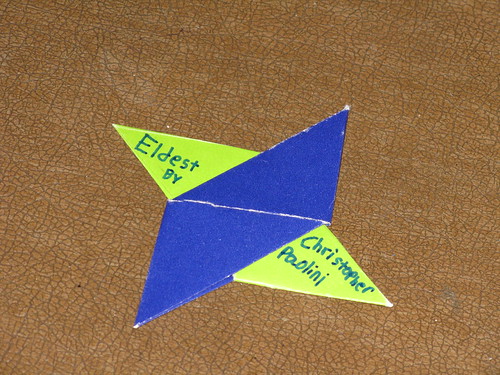I've had this fledgling idea in my head for months that I just haven't done anything with. The basic premise is a suburban high-school kid who thinks he's a highly trained ninja. I'm not sure yet how much is true and how much is in his head, but I think it's a story that could walk a fun line between real and imaginary and make all kinds of jokes and references to things I like.
Sitting in one of the webcomic panels at Balticon Miss L suggested working on the story together as a serial comic. She did a sketch and we've tossed around a couple more ideas.
Thursday I sat down and wrote a rough draft for a couple of scenes involving paper throwing stars. But while I appreciate the art of comics I really don't know how to write for comics, at least in the technical sense. How much do you write beyond the plot and dialogue? How detailed in descriptions do you get, and how much freedom do you give the artist? My only reference really is a book I read on Neil Gaiman, who's apparently a real stickler for detailing out how he wants every panel to look on the page.
So yesterday I went to the comic book section in my library with limited success. Not surprisingly most of the books focus on drawing and layout, but we did have one by Dennis O'Neil titled The DC Comics Guide to Writing Comics. I started flipping through it and what do I find but this:
Now I'm not particularly religious or even spiritual. But I do believe that sometimes the universe gives us little hints when were on the right track. This little paper shuriken is more than a little hint. I don't know where this project will go or if anyone other than Miss L and I will ever see it, but I'm more sure now that we need to give this story a shot and just see where our creativity takes us.
Excelsior.

4 comments:
You might find this site useful.
http://calebmonroe.com/comic-writer-services/
Effectively when I'm working on a serial I do a basic outline that plots out a full arc as it runs through however many issues I've determined.
From there I used to go straight to scripting. Now however I use a trick that Matt Fraction talked about, put the number 1-22 (or however many pages you have) on a page and write a one line description of what happens on that page. After that move to scripting. Makes scripting far less cumbersome.
As far as how much to write, it's solely dependent on the artist you are working with. When I work with someone I don't know well, I tend to put a lot more detail in. If it's someone I trust and have worked with for a while I put very little.
Best bet is to ask your artist how much they want. Also, always let them know they have full reign to change something if it doesn't out and out break the plot.
Hi Steve-
The comic writer services page looks like a great resource. There's a lot to dig through there that should be really helpful. Thanks for sharing it. I'll give the scripting trick of yours a try as well.
Although I don't have a full plot for the main story yet, I think we're going to start with a simple short-short and see how the collaboration goes for us.
At the back of many of the Powers TPBs (including the last one), Bendis includes a copy of his script for at least one of the issues. I've always found these interesting, especially as you can see the differences between what Bendis originally concieved and how Oeming interpreted the scenes. Bendis, being an artist himself, I think adds a little bit more than the average writer in terms of perspective, angles, etc. I think you'll have to work it out with Miss L exactly how much direction she wants, but if you can find other scripts to look at it might help.
I love Powers. I read it mostly in issue, so I didn't know about that little bonus in the TBP. Thanks! Examples are probably what will help most at this point. Now that I think about it, I believe some of the Fables TBP have copies of scripts as well.
I think this whole thing will be a learning process for both Miss L and I. I'll be pretty open to her ideas and vice versa, but knowing different approaches could really help.
Post a Comment